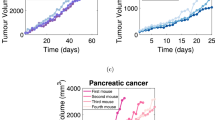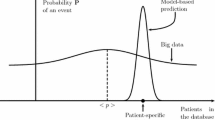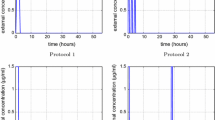Abstract
The idea that one can possibly develop computational models that predict the emergence, growth, or decline of tumors in living tissue is enormously intriguing as such predictions could revolutionize medicine and bring a new paradigm into the treatment and prevention of a class of the deadliest maladies affecting humankind. But at the heart of this subject is the notion of predictability itself, the ambiguity involved in selecting and implementing effective models, and the acquisition of relevant data, all factors that contribute to the difficulty of predicting such complex events as tumor growth with quantifiable uncertainty. In this work, we attempt to lay out a framework, based on Bayesian probability, for systematically addressing the questions of Validation, the process of investigating the accuracy with which a mathematical model is able to reproduce particular physical events, and Uncertainty quantification, developing measures of the degree of confidence with which a computer model predicts particular quantities of interest. For illustrative purposes, we exercise the process using virtual data for models of tumor growth based on diffuse-interface theories of mixtures utilizing virtual data.













Similar content being viewed by others
References
Adams BM, Bohnhoff WJ, Dalbey KR, Eddy JP, Eldred MS, Gay DM, Haskell K, Hough PD, Swiler LP (2009) DAKOTA, a multilevel parallel object-oriented framework for design optimization, parameter estimation, uncertainty quantification, and sensitivity analysis: version 5.0 user’s manual. Tech Rep SAND2010-2183, Sandia National Laboratory
Amar MB, Chatelain C, Ciarletta P (2011) Contour instabilities in early tumor growth models. Phys Rev Lett 106:148101
Ambrosi D, Mollica F (2002) On the mechanics of a growing tumor. Int J Eng Sci 40(12):1297–1316
Ambrosi D, Preziosi L (2002) On the closure of mass balance models for tumor growth. Math Models Methods Appl Sci 12(5):737–754
Anderson ARA, Chaplain MAJ (1998) Continuous and discrete models of tumor-induced angiogenesis. Bull Math Biol 60:857–899
Araujo RP, McElwain DLS (2005) A mixture theory for the genesis of residual stresses in growing tissues I: a general forumulation. SIAM J Appl Math 65:1261–1284
Babuška I, Nobile F, Tempone R (2007) A stochastic collocation method for elliptic partial differential equations with random input data. SIAM J Numer Anal 45(3):1005–1034
Babuška I, Nobile F, Tempone R (2008) A systematic approach to model validation based on Bayesian. CMAME 197:2517–2539
Byrne HM, Gourley SA (1997) The role of growth factors in avascular tumour growth. Math Comput Model 4:35–55
Byrne H, Preziosi L (2003) Modelling solid tumour growth using the theory of mixtures. Math Med Biol 20:341–366
Caffarelli LA, Muler NE (1995) An \(L^\infty \) bound for solutions of the Cahn–Hilliard equation. Arch Ration Mech Anal 133:129–144
Chaplain MAJ, Sleeman BD (1993) Modelling the growth of solid tumours and incorporating a method for their classification using nonlinear elasticity theory. J Math Biol 31:431–473
Coleman BD, Noll W (1963) The thermodynamics of elastic materials with heat conduction and viscosity. Arch Ration Mech Anal 13:167–178
Coleman HW, Steele WG (2009) Experimentation, validation, and uncertainty analysis for engineers. Wiley, New York
Cristini V, Li X, Lowengrub JS, Wise SM (2009) Nonlinear simulations of solid tumor growth using a mixture model: invasion and branching. J Math Biol 58:723–763
DiMilla PA, Barbee K, Lauffenburger DA (1991) Mathematical model for the effects of adhesion and mechanics on cell migration speed. J Biophys 60:15–37
Elliott C (1989) Mathematical models for phase change problems. In: Rodrigues J (ed) Proceedings of the European workshop held at Óbidos, Portugal, 1988, International Series of Numerical Mathematics, vol 88. Birkhäuser, pp 35–73
Elliott C, Garcke H (1996) On the Cahn–Hilliard equation with degenerate mobility. SIAM J Math Anal 27(2):404–423
Eyre D (1998) Computational and mathematical models of microstructural evolution. In: Bullard JW, Chen LQ, Kalia RK, Stoneham AM (eds) Material Research Society Symposium Proceedings, vol 529. Materials Research Society, Warrendale, pp 39–46
Frieboes HB, Jim F, Chuang YL, Wise SM, Lowengrub JS, Cristini V (2010) Three-dimensional multipspecies nonlinear tumor growth-II: tumor invasion and angiogenesis. J Theor Biol 264:1254–1278
Gelman A, Carlin JB, Stern HS, Rubin DB (2004) Bayesian data analysis, 2nd edn. Chapman& Hall/CRC, Boca Raton
Ghanem RG, Spanos PD (1991) Stochastic finite elements: a spectral approach. Springer, Berlin
Hawkins-Daarud AJ (2011) Toward a predictive model of tumor growth. Ph.D. thesis. The University of Texas at Austin, Austin
Kaipio J, Somersalo E (2005) Statistical and computational inverse problems. Springer, Berlin
Kleiber M, Hien TD (1992) The stochastic finite element method. Wiley, New York
Kullback S, Leibler RA (1951) On information and sufficiency. Ann Math Stat 22(1):79–86
Liu WK, Belytschko T, Mani A (1986) Random field finite elements. Int J Numer Methods Eng 23:1831–1845
Loh WL (1996) On Latin hypercube sampling. Ann Stat 25(5):2058–2080
Oberkampf WL, Roy CJ (2010) Verification and validation in scientific computing. Cambridge University Press, Cambridge
Oden J, Moser R, Ghattas O (2010a) Computer predictions with quantified uncertainty, part I. SIAM News 43(9)
Oden J, Moser R, Ghattas O (2010b) Computer predictions with quantified uncertainty, part II. SIAM News 43(10)
Oden JT, Hawkins A, Prudhomme S (2010c) General diffuse-interface theories and an approach to predictive tumor growth modeling. Math Models Methods Appl Sci 20(3):477
Prudencio E, Schulz K (2012) Euro-Par 2011 workshops, part 1, volume 7155 of Lecture Notes in Computer Science. Springer, Berlin, pp 398–407
Roache PJ (2009) Fundamentals of verification and validation, 2nd edn. Hermosa Publishers, New Mexico
Spiegelhalter DJ, Best NG, Carlin BP, van der Linde A (2002) Bayesian measures of model complexity and fit. J R Stat Soc 64(4):583–639
Tarantola A (2005) Inverse problem theory and methods for model parameter estimation. SIAM Publishers, Philadelphia
Ward JP, King JR (1997) Mathematical modelling of avascular tumour growth. IMA J Math Appl Med Biol 14:36–69
Wise SM, Lowengrub JS, Frieboes HB, Cristini V (2008) Three-dimensional diffuse-interface simulation of multispecies tumor growth-I. Model and numerical method. J Theor Biol 253(3):523–543
Wise SM, Wang C, Lowengrub JS (2009) An energy-stable and convergent finite-difference scheme for the phase field crystal equation. SIAM J Numer Anal 47(3):2269–2288
Wise SM (2010) Unconditionally stable finite difference, nonlinear multigrid simulation of the Cahn–Hilliard–Hele–Shaw system of equations. J Sci Comput 44:38–68
Acknowledgments
The authors gratefully recognize the support by the Department of Energy under Award Number DE-FC52-08NA28615 and by the National Science Foundation under Grant No. 1115865. K.v.d.Z. also acknowledges the support of the Netherlands Organisation for Scientific Research (NWO) via the Innovational Research Incentives Scheme (IRIS), Veni grant 639.031.033. The authors also acknowledge useful discussions with Ivo Babuška, Hector Gomez, Luca Dede, and Jesse Windle.
Author information
Authors and Affiliations
Corresponding author
Appendix A: Discretization of the models
Appendix A: Discretization of the models
In this section, we consider the discretization and numerical solution of the three models described in Sect. 4.2. We consider a mixed finite element approximation in space combined with a semi-implicit time-stepping algorithm. We focus on model \(\mathcal M _3\) given in (26). The discretization of \(\mathcal M _1\) can be derived from \(\mathcal M _3\) as a special case. Of course, \(\mathcal M _2\) is equivalent to \(\mathcal M _3\) up to time-independent parameters.
1.1 A.1 Weak formulation
Anticipating possible low regularity in solutions and in preparation for general mixed finite element approximations, we first consider a weak-mixed formulation of (26). Let \(\mathsf{V},\,\mathsf{V}_g\) and \(\mathsf{W}_{u_0}\) denote the spaces
In particular, note that \(\mathsf{V}_0 = L^2\left(0,T; H^1_0(\varOmega )\right)\) and \(\mathsf{V}_1 = \{1\} + \mathsf{V}_0\). We shall now define a weak solution of (25) to be a triple \(\mathbf{u}:=(u,\mu ,c) \in \mathsf{W}_{u_0} \times \mathsf{V} \times \mathsf{V}_1 \) such that
where \(B\left(\cdot ; \cdot \right)\) is the semi-linear form,
\(\left\langle \cdot ,\cdot \right\rangle \) denotes the duality pairing between \(\left(H^1 \left(\varOmega \right)\right)^{\prime }\) and \(H^1\left(\varOmega \right),\,\left(\cdot ,\cdot \right)\) denotes the \(L^2\) inner product over \(\varOmega \), and \(\left(\cdot ,\cdot \right)_{\partial \varOmega }\) is the \(L^2\) inner product over \(\partial \varOmega \).
The well-posedness of the above weak formulation (40) is an open question not considered here. The major difficulties are the nonlinear mobility \(M u^2\) and the nonlinear coupling between \(c\) and \(u\), i.e. the reaction terms \(cu\). On the other hand, the simpler model \(\mathcal M _1\) is a compact perturbation of the Cahn–Hilliard equation, the well-posedness of which can be proven; see for instance Elliott (1989) and Elliott and Garcke (1996). The semilinear form (41) is bounded above for \(u\) bounded [in \(\mathsf{W}_{u_0} \subset L^\infty (0,T;L^\infty (\varOmega ))\)], but this may not be true for certain cases (see Caffarelli and Muler (1995) for a related result for the Cahn–Hilliard equation).
1.2 A.2 Semi-discrete finite element approximations
We now address the construction of semi-discrete conforming finite element approximations of the system (40). Such a formulation involves a discretization of the spatial variations of \(\left(u,\mu ,c\right)\) keeping, for the moment, the time variations continuous in time.
Let \(\mathcal T ^h\) denote a member of a family of partitions of domain \(\varOmega \) into meshes of non-overlapping convex finite elements \(\varOmega _k\) such that \(\overline{\varOmega } = \bigcup _{k=1}^{N\left(h\right)} \overline{\varOmega }_k\) and \(\varOmega _k\cap \varOmega _j = \emptyset ,\, k\ne j\). Each \(\varOmega _k\) is the image of a master element \(\tilde{\varOmega }\) under an invertible (generally affine) map \(F_k\). We construct finite-dimensional subspaces of \(H^1\left(\varOmega \right)\) and \(H^1_0(\varOmega )\) defined by
and \(\mathcal S ^h_0 := \mathcal S ^h \cap H_0^1(\varOmega )\), respectively. We further set \(\mathcal S ^h_1 := \{1\} + \mathcal S ^h_0\). Here \(\mathbb P ^K(\tilde{\varOmega })\) is either the space of polynomials of degree \(\le K\) defined on the closure of \(\tilde{\varOmega }\) or the space of tensor products of polynomials of degree \(K\) on the closure of \(\tilde{\varOmega }\). With these notations and conventions in place, the semi-discrete approximation \(\mathbf{u}^h := (u^h,\mu ^h,c^h):[0,T]\rightarrow \mathcal S ^h\times \mathcal S ^h \times \mathcal S ^h_1\) is defined as follows:
for a.e. \(t\in (0,T)\). The initial condition for \(u^h\) is set by \(u^h(0) = \mathcal I ^h \, u_0\), where \(\mathcal I ^h: H^1(\varOmega )\rightarrow \mathcal S ^h\) is a suitable interpolation or projection.
Let us denote by \(\left\{ \varphi _i\left(\mathbf{x}\right)\right\} _{i=1}^N\) a set of basis functions of \(\mathcal S ^h\) generated on a partition \(\mathcal T ^h\) by the finite element approximations: \(\mathcal S ^h = \text{ span}\left\{ \varphi _i\right\} \). Then each of the component approximations is of the form
Here \(u_i\left(t\right),\,\mu _i\left(t\right)\) and \(c_i\left(t\right)\) are continuous functions in time. Upon introducing these into (43), we obtain a system of nonlinear ordinary differential equations (ODE’s) in the unknown discrete variables, \(u_i\left(t\right),\,\mu _i\left(t\right)\) and \(c_i\left(t\right)\). We proceed by developing a time discretization of these ODE’s.
1.3 A.3 Time discretization
An attractive class of robust schemes for time-integration of Cahn–Hilliard-type problems are semi-implicit schemes Eyre (1998); Wise et al. (2009); Wise (2010). Semi-implicit schemes are preferred for their superior stability properties allowing large time-steps to be taken. These schemes split the free energy \(f\) in a contractive and expansive part, \(f(u) = f_c(u) - f_e(u)\), and accordingly treat \(f_c\) implicitly and \(f_e\) explicitly. The splitting is such that \(f_c\) and \(f_e\) are both convex functions, at least in the domain of interest (for \(u\in [0,1]\)). We shall employ the splitting \(f_c(u) = \frac{3}{2}\, u^2\) and \(f_e(u):=f_c(u)-f(u)\).
Let \(\varDelta t\) denote the time step and \(t_n = n \varDelta t\), for \(n=0,\ldots , N:=T/\varDelta t\) corresponding discrete times. We denote the approximation to \(\mathbf{u}^h(t_n)\) by \(\mathbf{u}_n\). Then, the fully discrete approximation \(\mathbf{u}_n:=(u_n,\mu _n,c_n)\in \mathcal S ^h\times \mathcal S ^h \times \mathcal S ^h_1\) is defined recursively by
for \(n=1,\ldots , N\). The scheme is initialized using the initial condition \(u_0 = u^h(0) = \mathcal I ^h\,u_0\).
Note that analogous to \(f\), we have treated the other nonlinear terms \((M u^2 \nabla \mu ,\,cu)\) in a semi-implicit fashion. Since our splitting of \(f(u)\) resulted in a linear contractive part \(f^{\prime }_c(u)\), the above scheme requires the solution of a linear system of equations at each time step.
Rights and permissions
About this article
Cite this article
Hawkins-Daarud, A., Prudhomme, S., van der Zee, K.G. et al. Bayesian calibration, validation, and uncertainty quantification of diffuse interface models of tumor growth. J. Math. Biol. 67, 1457–1485 (2013). https://doi.org/10.1007/s00285-012-0595-9
Received:
Revised:
Published:
Issue Date:
DOI: https://doi.org/10.1007/s00285-012-0595-9




